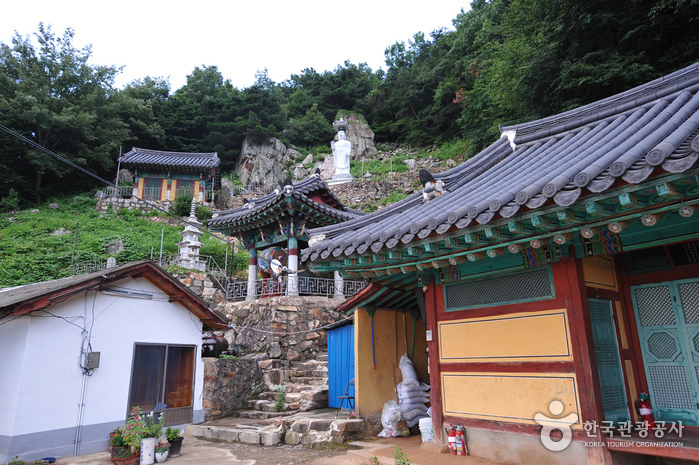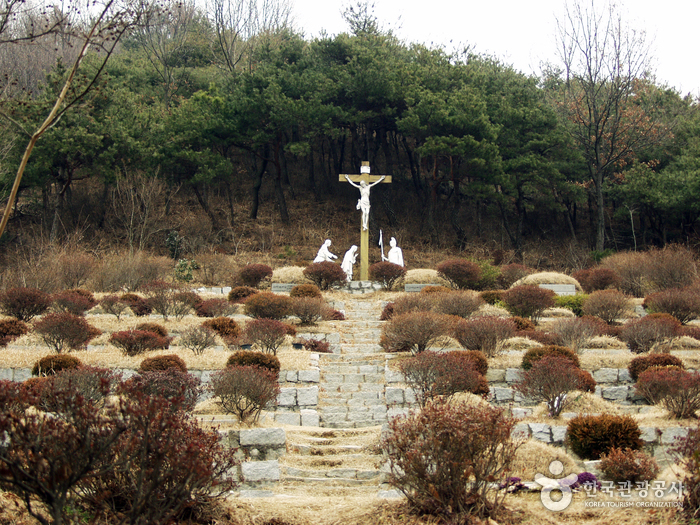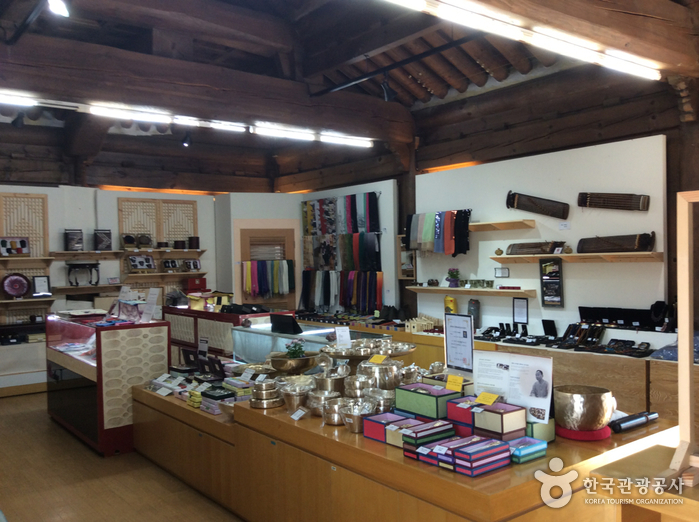Hanokstory [Korea Quality] / 한옥이야기 [한국관광 품질인증]
631.7976405166855m 4018 2024-04-07
83-14, Eunhaeng-ro, Wansan-gu, Jeonju-si, Région Jeonbuk
+82-10-9203-1111, +82-10-4166-7799
Hanok Story in Hyanggyo-gil in Jeonju Hanok Village is a traditional Korean house built over 60 years ago and was recently renovated to serve as a guesthouse. Thus, it boasts of modern convenient facilities but preserves most of the features of a traditional Korean house, which was home to the guesthouse owner and his wife for over 35 years. The couple put old books, LPs, old movie posters, Korean lunch boxes, and old television on display in every corner of the house to create an old look and finish. In the yard is a 50-year-old persimmon tree that provides cool shade during the summer and delicious persimmons in the fall. All the old items in the house have a story to tell, and that's why the owner named his guesthouse "Hanok Story."
At the entrance of the house is a Korean phrase meaning “Enjoy the Five Blessings (longevity, wealth, health, love of virtue, and peaceful death) generation after generation with the energy of the sun, moon, and stars.” That’s why the rooms are named “Geumbit (Golden Light),” “Haetbit (Sunlight),” “Dalbit (Moonlight),” and “Byeolbit (Starlight).” The phrase is also engraved on top of the door to the "Haetbit Room." There are a total of seven guestrooms -- four in the main building and the "Solbit Room," "Deluxe Room No. 1," and "Deluxe Room No. 2." All the rooms are furnished with bathroom, TV, and air conditioner. Deluxe Room No. 2 has a kitchen for the guests to cook. There is a garden of sowbread, balloon vine, and hydrangea in the yard.
There is also a cafeteria made of cypress wood in the yard. The walls are covered with post-its left by the guests as well as musical instruments and dolls. It's where tea and breakfast are served. Homemade Korean breakfast is served for free. A tea class is also available during the weekend upon reservation.
Gyo Dong Sal Rae [Korea Quality] / 교동살래 [한국관광 품질인증]
652.7674465448291m 846 2024-04-07
66-1, Jeonjucheondong-ro, Wansan-gu, Jeonju-si, Région Jeonbuk
+82-10-9043-6743
Located at the entrance to Namcheongyo Bridge, which flows over Jeonjucheon Stream, Gyodongsalrae is a hanok structure built in 1971. It consists of the sarangchae (men’s quarters), anchae (women’s quarters), and byeolchae (detached House) and has ten guestrooms in total. While the sarangchae is situated near the road, the anchae and byeolchae are located to the rear of the house. Each building has a well-maintained flowerbed filled with seasonal flowers that harmonize perfectly with the beauty of the hanok.
The interior of the house is decorated with a variety of antiques, paintings, embroidery and knitting works, creating a cozy atmosphere. The ten rooms are of different sizes and styles including an ondol (Korean floor heating system) room, a room with a bed, and a darak (garret) room. The sarangchae consists of the Changpobang, Maehwabang, Baerongbang and Mokryeonbang rooms, of which the last two have a terrace with an open view. The anchae consists of a living room (sarangbang) and a room for two people. The byeolchae with a small courtyard has three large rooms with a capacity of four to six people and a separate space for relaxation and breakfast.
Temple Donggosa (동고사)
678.7737973288681m 4342 2024-04-07
San 10, Gyo-dong, Wansan-gu, Jeonju-si, Région Jeonbuk
+82-63-288-1626
Le temple Donggosa est un temple bouddhiste de l’ordre Taego, situé sur le mont Seungamsan à Gyo-dong, dans la ville de Jeonju, au sein de la région du Jeollabuk-do. La randonnée jusqu’au temple est une expérience rafraîchissante, de par l’air frais environnant et de la vue panoramique sur le centre de Jeonju depuis le temple. Les bâtisses furent construites les unes après les autres le long de la crête et sont alignées avec Daeungjeon, le bâtiment principal situé au milieu.
Le temple Donggosa est de petite taille mais fut merveilleusement décoré avec des portraits de grands moines bouddhistes défunts et des peintures bouddhistes murales réalisées sur du bois. Le chemin de randonnée à la droite du temple Donggosa mène au domaine des martyrs de Chimyeongjasan, qui accueille les tombes de nombreux catholiques, persécutés pendant la période tardive de la dynastie Joseon.
Pont Namcheongyo (남천교 청연루)
679.0773500930442m 21386 2024-04-24
40, Cheongyeong-ro, Wansan-gu, Jeonju-si, région Jeonbuk
Le pont Namcheongyo est le principal pont pour entrer dans le village des hanok de Jeonju. Avec le projet dénommé "Jeonju Namcheongyo Luxury Project", la zone a connu des rénovations pour renforcer la structure et ajouter le pavillon Cheongyeonru.
Les visiteurs peuvent apprécier une vue panoramique de la zone depuis le pavillon hanok ou se reposer à l'abri de la chaleur en été.
Jeonggahanog [Korea Quality] / 정가한옥 [한국관광 품질인증]
694.2929029649868m 176 2024-04-07
78-3, Girin-daero, Wansan-gu, Jeonju-si, Région Jeonbuk
+82-10-9934-1300
Jeongga Hanok is a space where the traditional beauty of hanok and the modern comfort co-exists. The newly built Hanok is neat and pleasant. When you enter the small cobbled yard, the porch and the eaves will welcome you, and you’ll find that the rooms are filled with delicate wood fragrance. The interior is furnished with Korean cypress trees and red clay. In particular, the Cypress Tree room is all made of cypress trees, from the walls to the ceiling, making guests feel like they are lying in a forest. Maple Room and Ginkgo Tree Room, meanwhile, have attics.
Jeongga Hanok faces Jeonju Hanok Village with the Girin-daero in the middle. Hanok Village is just across the road. Major attractions such as Gyeonggijeon, Jeondong Catholic Cathedral, and Jeonjuhyanggyo Confucian School are all within walkable distance. Omokdae, which offers an unhindered view of Hanok Village, is located over the pedestrian overpass. Jaman Mural Village, famous for colorful mural and cozy cafes, is about 300 meters away and a great spot for selfie lovers.
Gyodonggaon [Korea Quality] / 교동가온 [한국관광 품질인증]
698.0325676440087m 7285 2024-04-07
73-1, Eunhaeng-ro, Wansan-gu, Jeonju-si, Région Jeonbuk
+82-10-5106-3355
Gyodong Gaon is located right in the middle of the main street of Jeonju Hanok Village. The word "gaon" means "middle" in Korean. It's a two-story traditional Korean house that stands out among the rest of the traditional Korean houses in the alley leading to Omokdae. Just inside the gate is a yard with colorful flower trees, jars of sauces, and furnace. The mural on one of the walls is popular among the guests as a place to take photos.
The "numaru", or "loft" in Korean, overlooks the Hanok Village, and is one of the best places in the village to get a closer look at the 500 year old zelkova tree and the foot of the mountain nearby. Open to all the guests, the "numaru" is very popular during the winter as well as the summer. It's an open space with a wooden floor, so it's very cool during the summer, and it also serves as an observatory to enjoy the view of all the snow-covered trees and roofs in the Hanok Village during the winter while having a hot cup of tea.
The owner of the guesthouse has been living here for 37 years. He rebuilt his house and turned it into a hanok guesthouse in 2014 while making sure the rooms are well insulated and comfortable to stay.
He built a two-story building to make an efficient use of the space, and focused on making all the rooms look different. The house has five rooms, and only the “Meomulda Room” on the first floor is the only rooms with a living room separated from the bedroom. All you have to do is open the door to enjoy the view of the yard, Hanok Village, and Omokdae. The “Nanuda Room” on the second floor is the largest one that can accommodate more than five people, making it the most popular choice among families. The "Damda Room" and "Kkumkkuda Room" both have an attic that can be reached by a ladder. The attic is big enough to sleep two adults, and some guests actually sleep there for a unique experience. One of the walls of the attic is finished with cypress wood which has a pleasant scent. The “Geurida Room” has the best view through the two windows on the either side of the room, in addition to warm sunlight and cool wind that come through the window. Modern, not traditional, doors are installed in all the rooms for better sound proofing and insulation.
Gyodong Gaon offers a number of experience programs, such as traditional games like “gulleongsoe”, “tuho", and “Korean top”, As well as “sabang chigi”, “sampalseon”, and “ttangttameokgi”.
Many Korean adults are familiar with these games, while children and foreigners can find these games interesting. All these traditional Korean games are free to play.
Montagne des Martyrs (Chimyeongjasan) (천주교성지 치명자산)
708.2679841558783m 3319 2024-04-07
103-88, Naksujeong2(i)-gil, Wansan-gu, Jeonju-si, Région Jeonbuk
+82-63-285-5755
La montagne des martyrs est l’oeuvre des catholiques persecutés de Jeonju au 18ème siècle. De nombreux martyrs y sont enterrés y compris un couple marié qui fit le voeu de rester vierge pour l’éternité. Le mari de ce fameux couple est Lee Jong-cheol, son père, un autre martyr décida qu’il devait se marier mais rester pieux et pure.
Ce sont sept personnes de sa famille qui reposent dans ce cimetière. Il existe aussi un chemin de croix et une cathédrale.
Bukyungdang [Korea Quality] / 부경당 [한국관광 품질인증]
725.6350255483613m 225 2024-04-07
99-5, Hanji-gil, Wansan-gu, Jeonju-si, Région Jeonbuk
+82-10-5327-8736
Located at the heart of the Jeongju Hanok Village, Bugyeongdang is a beautiful traditional 60-year old Hanok.
Traditional floor, roof tiles, and jar stands next to stone walls, while small garden and flower beds reflect the architect couple's attentive hands. As a Hanok with one of the prettiest gardens in Jeonju Hanok Village, it is a good place to appreciate the garden flowers and enjoy the unique laid-back atmosphere of Hanok while sitting on the floor. The place is close to major tourist attractions including Imokdae, Gyeonggijeon, Jeondong Catholic Cathedral, and Hyanggyo.
The owner, who was born and raised in the Jeonju Hanok Village, describes must-go sites like a tour guide and introduces undiscovered great restaurants or things-to-do to the guests. As the owner, who had long been engaged in architecture, takes care of the Hanok, the building always stays clean and in good condition.
In the shared kitchenette, guests can prepare simple breakfast for themselves with the dishes and cups made by the wife of the owner herself. Luggage storage services before check-in and after check-out, and description of tourist attractions are provided.
Centre des trésor de Jeonju (전주 공예품전시관, 명품관)
728.559932993756m 1521 2024-04-07
15, Taejo-ro, Wansan-gu, Jeonju-si, Région Jeonbuk
+82-63-285-4404
Pour les personnes recherchant de l'artisanat de haute qualité dans la région de Jeonju, le Centre des Trésors de Jeonju est l'endroit idéal pour faire des achats. Le Seonjacheong propose des éventails traditionnels, le Hanjigwan met en vente des produits fabriqués en papier coréen traditionnels, et l'Omokdae expose des objets en bois et d'autres produits. Il est très agréable de s'y promener et d'y admirer les produits, même si vous n'avez pas l'intention d'acheter.
Musée de la calligraphie Gangam (강암서예관)
729.2741663013516m 3704 2024-04-07
74, Jeonjucheondong-ro, Wansan-gu, Jeonju-si, Région Jeonbuk
+82-63-285-7442
Inauguré en 1995, le musée Gang-am est un établissement spécialisé en calligraphie. Situé dans le village des hanok (maisons traditionnelles coréennes) de Jeonju, il expose environ mille œuvres de calligraphes illustres tel que Kim Jeong-Hui (1786-1856, peintre, calligraphe et savant), Lee Sam-Man (1770-1845, calligraphe), Kim Hong-Do (1745- ?, peintre), Jeong Yak-yong (1762-1836, savant), etc.. Le musée s’étend sur 872 ㎡, il comporte des salles d’expositions et des salles de conférences. Sa collection comprend 1.162 pièces.
![Hanokstory [Korea Quality] / 한옥이야기 [한국관광 품질인증]](http://tong.visitkorea.or.kr/cms/resource/20/2046320_image2_1.jpg)
![Gyo Dong Sal Rae [Korea Quality] / 교동살래 [한국관광 품질인증]](http://tong.visitkorea.or.kr/cms/resource/71/2556371_image2_1.jpg)


![Jeonggahanog [Korea Quality] / 정가한옥 [한국관광 품질인증]](http://tong.visitkorea.or.kr/cms/resource/62/2594362_image2_1.jpg)
![Gyodonggaon [Korea Quality] / 교동가온 [한국관광 품질인증]](http://tong.visitkorea.or.kr/cms/resource/75/2049675_image2_1.jpg)

![Bukyungdang [Korea Quality] / 부경당 [한국관광 품질인증]](http://tong.visitkorea.or.kr/cms/resource/29/2593529_image2_1.jpg)


 Français
Français
 한국어
한국어 English
English 日本語
日本語 中文(简体)
中文(简体) Deutsch
Deutsch Español
Español Русский
Русский